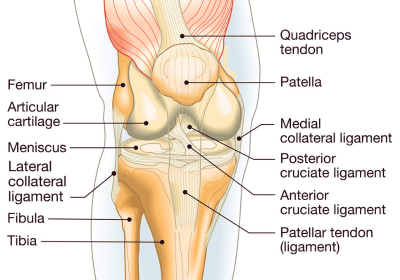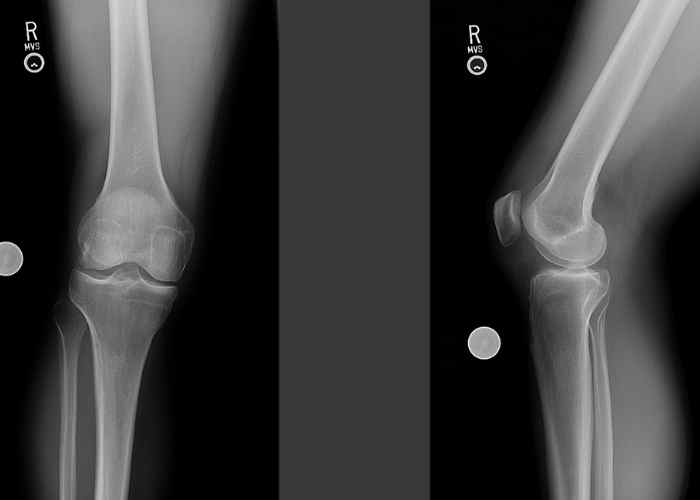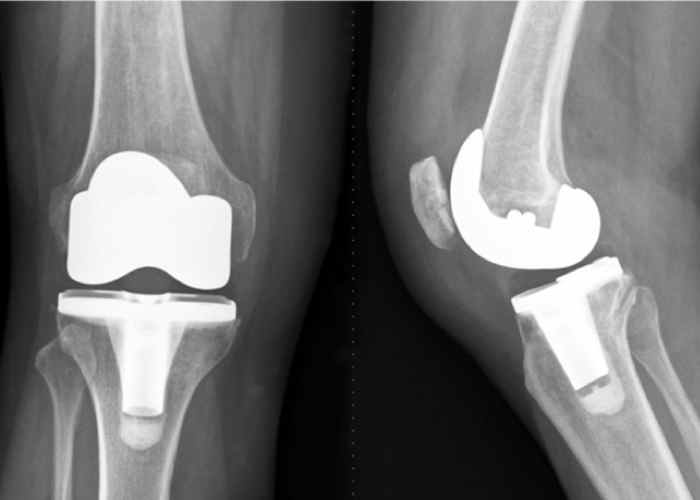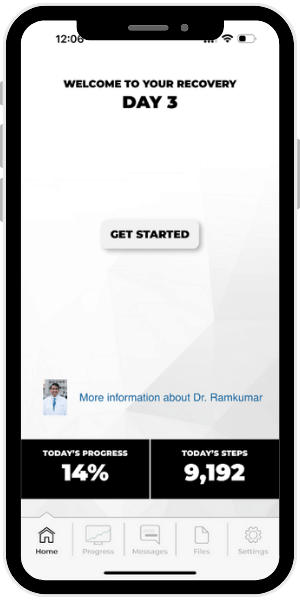Robotic Knee Replacement Surgeon
A total knee replacement is best reserved for patients who have exhausted all non-surgical treatments. Dr. Ramkumar is trained to perform total knee replacements from many different designs and different techniques but exclusively uses the MAKO robotic arm, potentially offering a more accurate operation. It is important to understand that all robotic joint replacements are the same, but that the MAKO is best-in-class and the most time-tested. Knee doctor, Prem N. Ramkumar MD, serves patients in Los Angeles, Orange County, and surrounding Southern California areas. Contact Dr. Ramkumar’s team today!

What is a total knee replacement or total knee arthroplasty (TKA) surgery?
There are three “compartments” that make up the knee:
- Medial (inside of the knee)
- Lateral (outside of the knee)
- Patellofemoral (front of the knee under the kneecap and above the thighbone)
Degenerative joint diseases such as osteoarthritis and rheumatoid arthritis, may affect anywhere between one of these compartments (unicompartmental arthritis) to all of the compartments (global arthritis). If all three compartments are involved, and conservative treatments fail to provide relief or restore mobility to the knee joint, a total knee replacement may be beneficial. Deciding when to have a total knee replacement, also called total knee arthroplasty (TKA) surgery, is a deeply personal decision, and only you know when it’s time! Dr. Ramkumar only has the privilege of seeing you for a small window, but only you know what your day-do-day mobility and pain is like. Dr. Ramkumar can tell you when you’re a candidate for a total knee replacement after evaluating you, but he can never tell you if you “need” one.
During this surgical procedure, Dr. Ramkumar will replace all three areas of the knee joint with metal (Cobalt Chromium or Titanium) and plastic (Polyethylene). Metal will cover the worn-down surfaces of the femur and tibia, plastic will cover the patella, and a plastic insert will act as the new meniscus. The new frictionless surfaces restore motion and relieve pain. Total knee replacement research has dramatically changed over the last ten years, due to improved implant design, surgical execution, and better long-term evidence. Dr. Ramkumar is trained to perform total knee replacements from many different designs and different techniques but exclusively performs MAKO robotic knee replacement surgery using a robotic arm. The data surrounding the use of this technology indicates that it potentially offers a more accurate operation and faster recovery (which has been consistent with Dr. Ramkumar’s experience), but this has not been yet universally accepted in large part due to the current void of high quality research. It is important to understand that all robotic joint replacements are the same, but that the MAKO is best-in-class and the most time-tested. Dr. Prem N. Ramkumar, total knee replacement surgeon, is located in Long Beach and serves patients in Los Angeles, Orange County, and surrounding Southern California areas.
What is MAKO robotic knee replacement surgery?
MAKO refers to the MAKO robotic-arm-assisted surgery system by industry leader Stryker. It assists Dr. Ramkumar with pre-planning the total knee replacement using a 3-D model of the patient’s knee. During surgery, Dr. Ramkumar uses the MAKO robotic arm to remove the diseased parts of the knee while preserving healthy bone and tissue. The MAKO then helps Dr. Ramkumar find the ideal position and size of the knee implant down to half a millimeter and half a degree with respect to your specific anatomy. Dr. Ramkumar uses the MAKO system because his experience is consistent with early data that it offers patients the fastest and safest recovery.
Who is a candidate for a total knee replacement?
Patients with clinically severe symptoms and radiographically severe arthritis are excellent candidates for a total knee replacement. Severe symptoms include pain with movement of your knee, stiffness, and difficulty performing your activities of daily living. A total knee replacement is best reserved for patients who have exhausted all non-surgical treatments like activity modification, weight loss (where appropriate), anti-inflammatory medications, injections, and physical therapy. (Patients over 55, see “Considerations for Potential Hip and Knee Replacement Patients over 55.”)
Who is a candidate for TKA surgery or total knee replacement?
Patients with clinically severe symptoms and radiographically severe arthritis are excellent candidates for a total knee replacement. Severe symptoms include pain with movement of your knee, stiffness, and difficulty performing your activities of daily living. TKA surgery is best reserved for patients who have exhausted all non-surgical treatments like activity modification, weight loss (where appropriate), anti-inflammatory medications, injections, and physical therapy.
What is the recovery process after MAKO robotic knee replacement surgery?
Some patients spend a day or two in the hospital after a total knee replacement, while others go home the same day. This is largely dependent on the patient’s wishes and health status. You will be sent home with crutches or a walker and given specific instructions to reduce pain and swelling. Weight-bearing is limited to 75% until the first follow-up visit, at which point full weight bearing is encouraged. You should be able to walk without any assistance within a few weeks.
Dr. Ramkumar will recommend physical therapy to help you regain strength and restore mobility.
You will be enrolled into Dr. Ramkumar’s remote patient monitoring program that allows his TKA patients to review instructions digitally, upload wound photos, fill out satisfaction surveys, review your biometrics (heart rate, step count, sleep pattern), perform rehabilitation exercises per protocol (range of motion check), and receive direct messages from the office. You will need a smartphone (either an iPhone or Android) to be digitally connected.
How long does a total knee replacement last and what are the restrictions?
Thanks to advanced technology, a total knee replacement can last 20 to 30 years or even longer.
From an activity standpoint, Dr. Ramkumar does not have any restrictions on what you can or cannot do physically. Allow pain to be your guide. It is important you follow-up for maintenance checks at one year, five years, and ten years even if you have no issues! Assessment of the implants is important with follow-up to detect a problem before you may even realize it, although this is rare.
Do I need antibiotics to help prevent my knee from infection before a dental cleaning or colonoscopy?
Dr. Ramkumar prefers you wait to undergo these procedures for at least a year after your joint replacement if possible. Definitely do not do so within the first six months as the knee is still recovering, even if you already feel great.
When you need to go to a dentist or undergo a colonoscopy, Dr. Ramkumar insists you take antibiotics beforehand. For dental visits, you should take Amoxicillin 500mg x 4 one hour prior to procedure; if you have a penicillin allergy, you should take Erythromycin 500mg x 2 one hour prior to procedure; and if cannot take Amoxicillin or Erythromycin then you should take Clindamycin 300mg x 2 one hour prior. For colonoscopies, you should take Metronidazole 500mg x 2 one hour prior to procedure.
What can I expect before and after the total knee arthroplasty surgery?
Dr. Ramkumar emphasizes the importance of establishing clear expectations and providing comprehensive pre- and post-surgery education. This proactive approach not only alleviates anxiety but also leads to an enhanced overall surgical outcome.
What does the process look like leading up to TKA surgery?
We follow a detailed process and checklist to ensure your safety prior to undergoing total hip replacement. Although total hip replacement is a common operation, it is a very important life event, and we want to minimize as many preventable risks as possible.
Learn more >> Preoperative Assessment for Joint Replacement/Resurfacing Surgery
What happens after TKA surgery?
Our post operative guidelines offer an overview of what you can expect after your surgery, such as:
- How do you address pain management and nausea after surgery?
- Between all the medications and physical therapy, what do the first few days look like after surgery?
- What do the first few days look like after surgery?
- What activities can I do right after surgery?
- Is swelling and bruising after surgery normal?
- Is it normal to have sleep issues after hip replacement and what can I do about it?
- When can I bathe after surgery?
- When can I drive after surgery?
Learn more >> Postoperative Guidelines for Joint Replacement/Resurfacing Surgery
Selecting an orthopedic hip surgeon with experience performing total knee arthroplasty is crucial to a positive outcome. Dr. Prem Ramkumar is located in Long Beach and serves patients in Los Angeles, Orange County, and surrounding Southern California areas.





